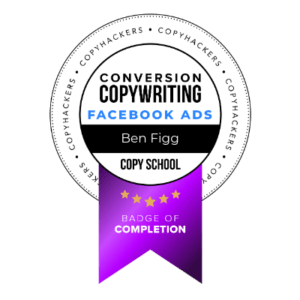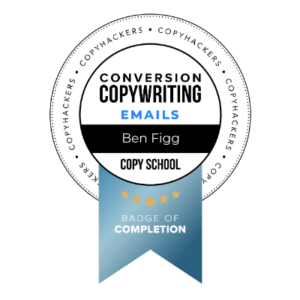DO OUR PHILOSOPHIES ALIGN? HAVE YOU FOUND THE RIGHT CONVERSION STRATEGIST AND COPYWRITER TO HELP YOU SELL? YOU CAN FIND OUT HERE…
How a once directionless Suffolk boy discovered why people buy and how to differentiate in business
Plus: 11 ½ psych concepts to give your marketing a persuasive lift … the 6 most dangerous words in business … and … 9 fundamentals of selling
Dear Business Builder,
Of all life’s taught you so far, what stands out?
For me, it’s what may seem too abstract in this world of data, competition and goals. Yet it’s a skill the likes of Steve Jobs and Richard Branson have valued highly. Looking back, I can see why.
Like many youngsters, I had no idea what to do in life. School had been tough. And I was just some lad from Suffolk, England.
Then halfway through college, hungry to cram in extra work experience – and keen to earn extra cash – my girlfriend’s dad offered me some work.

By the end of the first day, I’d decided I too would become a tree surgeon. It just felt right. Despite my fear of heights. Though I knew I’d beat it. That was non-negotiable.
And that’s what stands out most for me – the value of intuition.
It served me well when training as a tree surgeon too. Because I soon grasped how many folks accept even the most misguided beliefs. (Have you found similar?)
This was too much. The professional standard was so low!
So in 2008, at 22, I started my own business. Despite people’s warnings of, ‘But, the economy!’ They no doubt saw the brashness of youth. I only remember following my intuition. Determined to…
“Think different”
Now. I’m no Einstein (one of Apple’s chief “misfits” mentioned in their 1997 marketing campaign).
Click to reveal psych concept #1
Psychological concept #1: Halo effect
Here’s why the halo effect works (and how you can tap into it):
- Positive associations: You can encourage your audience to associate particular traits with your brand and product by mentioning influential organisations or figures they know.
- Credibility and inspiration: Influential names can also lend credibility to what you say. Because it shows you draw inspiration from entities people respect.
- Emotional connection: You can mention entities people may already have strong emotional connections with. Then they can tap into those emotions, which helps to bring the story alive and make it more memorable.
Where could we test the halo effect (and other concepts) in your marketing?
Click here and get in touch on the next page. If I think I can help, we’ll start with a free chat. And you’ll get up to three free ideas (without obligation) to help you lift your conversions.
Yet I could see opportunity in an industry norm I couldn’t stand.
You see, many competitors would quote for anything. Anything! Partly because of fear they’d miss out on the work. And partly because of the six most dangerous words in business…
‘That’s how we’ve always done it.’
So they’d do the same shitty work that’s been the norm for decades. And vandalise clients’ trees. (Though most don’t know it, thanks to lingering fallacies about tree management.)
Trouble is, such crappy work leaves clients with worse issues in the long term. Plus avoidable recurring costs. And the odd tale of heartbreak.
Even those I’d looked up to did it. Even despite mounting science showing a better way. Why not constantly improve and seek to deliver more value?
So it was past time someone did different. Though I’d need to learn…
How to sell
And here, my intuition kicked in once again.
I pondered what competitors were overlooking. Why standards were so low. And what prospects really want.
So. I’d get to know them on a free initial site visit. And though most competitors did that too, what helped me stand out was to ask lots of questions. People weren’t used to it. Most contractors didn’t invest much time upfront.
Click to reveal psych concept #2
Psychological concept #2: Pattern interrupt
How do pattern interrupts work?
- Attention and memory: We notice changes in our environment. That’s how our ancestors kept safe as they evolved. So when the unexpected happens, our brain’s alert system goes off. And we pay attention.
- Disruption of automatic responses: Changes in expected patterns disrupt our automatic responses. So they make us more aware of our actions. And more likely to consider new information or products.
- Emotional engagement: As my story soon relates, emotions are crucial in human decision-making. And you can also use them to create a pattern interrupt to create a connection with your audience.
- Cognitive dissonance: You can say something that doesn’t fit people’s expectations. This can motivate them to resolve the dissonance by paying more attention to the message.
And how can you use pattern interrupts in your marketing? Here are four suggestions…
- Introduce something surprising (e.g. in an ad) to grab attention. Like an unusual image. A shocking statement. Or a unique format.
- Use humour or present ideas in a new way.
- Evoke strong emotions, like joy, surprise or discomfort.
- Engage your audience with interactive elements, like quizzes, polls or games. This injects some fun, or an opportunity to learn something useful, for example.
What’s the key? To understand what your audience thinks and feels throughout the customer journey. And then find ways to disrupt those patterns.
If you’d like to discuss how we could test pattern interrupts in your marketing…
Why not get in touch now? If I think I can help, we’ll start with a free chat. And you’ll get up to three free ideas (without obligation) to help you lift your conversions.
I’d also often challenge what others had told them … or … what they already believed. Then explained how they could avoid unnecessary damage to their trees.
Click to reveal psych concepts #3 ½ (see example two for the half concept)
Psychological concept #3: Loss aversion
Daniel Kahneman and Amos Tversky explained how people make decisions under risk and uncertainty.
For example:
- People fear losses at least twice as much as they value gains. So they feel the psychological distress of losing £100 much more than the pleasure of gaining £100.
- How you frame choices can affect people’s decisions:
- Positive frame (risk de-emphasised): “Get a risk-free guarantee”
- Negative frame (risk emphasised): “Avoid risk with our guarantee”
- Our brains do an amazing job of helping us make sense of the complex world around us. How? Using heuristics (or shortcuts) that lead to biases, including:
- Anchoring: “Was £100, Now £50” makes a product seem like a great deal. Because the original price serves as a psychological anchor.
- Social proof: When those we think of as similar to us take a certain action (like buying), we’re more likely to perceive that action as safe. So state the number of purchasers, positive testimonials, high rankings etc.
- Scarcity: People perceive higher value when something they want is in short supply. So find ethical reasons to limit stock and/or timeframes.
- People all over the world make irrational decisions every day. For instance, they fear their plane will fall out of the sky. Yet they jump in a car and hurtle along the motorway. Despite the higher risk of car accidents compared to plane crashes.
As you can see, this – and other biases – impact people’s decisions whether we like it or not. And because the brain’s key concern is safety, people don’t always make decisions for the better. So by understanding how decisions are made, we can help them take more positive actions.
Want to test concepts like this in your marketing (or get it done for you)?
Get in touch on the next page. If I think I can help, we’ll start with a free chat. And you’ll get up to three free ideas (without obligation) to help you lift your conversions.
Only once I got buy-in on my recommendations would I make an offer. And if people didn’t want to accept those offers? I’d wish them luck and move on.
Click to reveal psych concept #4
Psychological concept #4: Choice theory
Psychiatrist Dr. William Glasser suggested we have five basic needs:
- Survival.
- Love and belonging.
- Power.
- Freedom.
- Fun.
And in marketing, we can be more persuasive when we tap into these needs. For example…
- Empowering consumers: Giving people options gives them a sense of control and autonomy. Something we all want, right? Like with customisable products. Consumers can tailor their purchase according to their preferences.
- Choice architecture: We can structure choices to nudge people towards a desired outcome. Like making a certain option easier to get than a less desirable outcome. Supermarkets do this by placing certain products at eye level.
- Segmenting markets: We can consider how different consumers have different needs. Then, we can tailor our messages and offers to meet those needs. Like fitness products, for example. Runners have different requirements from cyclists and rock climbers. Because they buy based on the outcome a product helps them get.
- Product differentiation: We can differentiate products by highlighting features that meet specific needs. For example, a smartphone brand might emphasise security features, if that’s what consumers care about.
- Customer engagement: People engage more with brands that offer choices. So you can offer several payment options at checkout. Or ‘good and better’ offers on product pages or as an upsell.
How might we test this kind of knowledge in your marketing?
Why not click here and get in touch on the next page? If I think I can help, we’ll start with a free chat. And you’ll get up to three free ideas (without obligation) to help you lift your conversions.
How to win
Most of the time the phone rang off the edge of my desk. Even though it seemed risky to go against what both clients and peers accepted.
And it taught me to differentiate based on what clients wanted. Instead of trying to constantly make what I sold ‘better’ purely through the lens of my own biases.
And that’s how you can keep ahead of your competition. And charge for the value you provide.
That’s how you can avoid getting caught in the commodity trap.
Why people buy
Why did my strategy work? Partly because of costly signalling.
Click to reveal psych concept #5
Psychological concept #5: Costly signalling
In 1975, evolutionary biologist Amotz Zahavi showed that we – and all animals – give off hard-to-fake signals.
In marketing, costly signalling can help us convey beneficial (to the audience) traits. Things like high standards and production-quality. Exclusivity, prestige or luxury. And sustainability.
How can this help us? Because we create a heightened sense of value in our target audience’s minds. Provided it aligns with what they want.
So how could we test costly signalling in your marketing?
Is now a bad time to get in touch on the next page? If I think I can help, we’ll start with a free chat. And you’ll get up to three free ideas (without obligation) to help you lift your conversions.
Though it mostly worked because I established nine fundamentals of sales (and marketing)…
- Human connection.
- Empathy.
- Clarity.
- Demonstrated value.
- Differentiation.
- Handling objections.
- Trustworthiness.
- Making people’s decisions easy, while respecting their autonomy.
- Presenting a clear path forward.
What’s at the core of these fundamentals? Emotion. The single most influential factor in people’s decision-making. Think fear, anger, surprise, joy … and hope. Emotional states that motivate us.
Click to reveal psych concept #6
Psychological concept #6: Somatic markers
Neuroscientist Antonio Damasio showed people can’t make decisions without emotions.
He studied patients who had damage to their prefrontal cortex. (Part of the brain that’s involved in emotional-processing.)
Damasio found these patients struggled to make decisions. Despite their continued ability for rational reasoning.
And the mechanism? Somatic markers. Sensations that attach emotional significance to different options. They highlight what’s most important based on past experiences. Why? Because it reduces the cognitive load. And makes decision-making easier.
Though emotions and rational thought aren’t separate.
Damasio concluded that emotions help us make quick assessments of a situation. Then, we rationalise to make well-rounded decisions. (Most of the time, anyway.)
As with all these psychological techniques, we need one factor in place first: A detailed understanding of your audience. Because we need to know how they think and feel about their problem and the solutions available.
Ready to see how we can help more of your audience to buy?
Click here to get in touch on the next page. If I think I can help, we’ll start with a free chat. And you’ll get up to three free ideas (without obligation) to help you lift your conversions.
More by judgement than luck
The old way worked for competitors by sheer luck. Because they played into people’s misconceptions. And prospects assumed they were making safe decisions.
Why? Because of the bandwagon effect.
Click to reveal psych concept #7
Psychological concept #7: Bandwagon effect
People often adopt behaviours and attitudes they see others doing. In marketing, we can tap into this using…
- Social proof: Use testimonials, reviews, case studies, customer counts, endorsements etc.
- Popularity cues: Draw attention to certain products such as best-sellers etc.
- Limited offers: People perceive higher value when what they want is in short supply. So find ethical reasons to limit stock and/or timeframes for buying.
- User-generated content: Encourage your existing customers to share their experiences online. Then you can tap into their personal networks.
Need help putting all this together in the most persuasive way?
Contact me on the next page. If I think I can help, we’ll start with a free chat. And you’ll get up to three free ideas (without obligation) to help you lift your conversions.
Thing is, luck just isn’t a good business strategy. So how did I counter the bandwagon effect – while persuading prospects of a better way … and winning >65% of quotes?
By understanding and appealing to people’s emotions.
Then I realised…
The power of direct marketing
I tried advertising in different ways. Though I’ll confess, most of my first attempts failed.
Click to reveal psych concept #8
Psychological concept #8: Praftfall effect
What if I suggested you reveal a product flaw in your marketing? Maybe you’d tell me I’m crazy, right? That I’ve completely lost my marbles?
Well, maybe. Here’s why…
The Pratfall effect was first described by social psychologist Elliot Aronson in 1966.
Aronson found that when those we consider competent make a minor blunder, they’re more likeable and trustworthy.
Someone else who’s talked about this effect is Dr. Robert Cialdini, the leading social scientist in the field of influence.
An example Dr. Cialdini cites is how Warren Buffett has started his letters for Berkshire Hathaway shareholders by mentioning a flaw upfront. And how this makes his following statements all the more believable.
In marketing, the Pratfall effect can help humanise brands, boosting likeability and building trust with consumers.
For instance, if there’s an unavoidable aspect of your product that’s perceived by some as a minor flaw…
You can mention it upfront. So long as you otherwise deliver plenty of value (according to what customers seek).
And consider how that might help you to stand out. Because standard practice in business is to hide flaws. But isn’t that just silly? After all, customers aren’t stupid. And they don’t like to be treated as such. (Neither do they like to feel they’ve been tricked.)
Now, you should know that though some research supports the pratfall effect, others have contested its robustness. But that’s ok. Because either way…
The key in marketing is to always test. (Which I can also help you with.)
And remember: It’s crucial with this concept is for the person (or brand) making the admission to be viewed as competent and otherwise trustworthy. Otherwise, it can backfire.
That’s why I said above that you’d only want to admit to seemingly minor flaws or something that’s perceived by some as a flaw. (After all, you can’t please everyone.)
It goes without saying that a product with more serious flaws needs to be fixed before going to market. Because it doesn’t matter how good your targeting, offer or copy is. Or what psychological nudges you embed. No marketing can fix a faulty product.
So, assuming the masses agree you have an outstanding product … and you’d like to see how we can test concepts like this in your marketing…
Why not get in touch on the next page? It’ll only take you two minutes. And I’ll get back to you within two days.
(And don’t forget: The call’s free. And you’ll also get up to three free ideas – without obligation – to help you lift your conversions. Here’s the link again.)
Until it finally struck me. Rather than use “spray-and-pray” methods…
The most efficient way to market is to go direct.
That’s why online marketing took off. Because we can personalise the experience. And make it ultra-relevant. For any audience, anywhere.
Plus, direct marketing masters – like Claude Hopkins, John Caples, David Ogilvy, Gary Halbert and Eugene Schwartz – had already proved the concept and passed their teachings down the ages.
So I learned some of the basics. And sent letters to five hotel companies, knowing they’d need my services regularly. And…
One response led to a quarter of sales over five years
One short letter took such a huge weight off my shoulders as a business owner. This would become my Aha! moment.
And though I was focused on another passion at the time…
The marketing bug gnawed away.
Until I learned…
Copywriters have helped people sell for over 100 years
Pioneering copywriters like those mentioned above.
And yes. Those same principles do still work. Even today. Even online. Because though technology’s changed, what truly influences people – as discussed above – hasn’t. (See psych concepts for examples. Particularly concept #6.)
And I’d already seen how deep the impact of copy can run. Because when you sell more, it creates a ripple effect that benefits everyone it touches. You, your family, your colleagues, staff and suppliers. Their families. On top of those you serve.
So it was past time to realign. To reapply my obsession with human behaviour. To expand on what I’d learned about marketing and influence. And…
To figure out what mistakes and misconceptions are costing people sales in marketing. (Have you seen the 13 common mistakes I can help you avoid in my “Customer Cultivation” video?)
Click to reveal psych concept #9
Psychological concept #9: Curiosity gap
At the top of this page, you saw this subhead:
“Plus: 11 ½ psych concepts to give your marketing a persuasive lift … the 6 most dangerous words in business … and … 9 fundamentals of selling”
The point, of course, is to invite your curiosity. That’s why I chose “11 ½” concepts. Because odd numbers stand out. And it implies you’ll get information of value.
You can use it in your marketing when your audience needs specific information before they’ll act.
- The point is to pique interest. So only reveal some of the information people need. Like in teaser emails or ads that leave the viewer on a cliffhanger and, therefore, a reason to click.
- You could also use quizzes, polls and games to engage your audience. Then they’ll become active participants rather than passive recipients of information.
- Craft compelling stories that drip pieces of information to maintain interest and build anticipation.
- Offer previews or sneak peeks to generate excitement and curiosity. Make them more powerful with exclusivity for certain segments. (Like your best customers or those who opt-in by a certain deadline.)
- Incorporate elements of mystery and surprise like mystery boxes or surprise discounts. (Though it only works if it’s a genuine surprise.)
A great example of how curiosity is often used in marketing is in movie trailers. Good trailers tease the story and leave you wanting to see the film. But…
How many films have disappointed you … despite the teaser doing a great job? Therein lies a warning. It’s crucial to deliver on what’s promised when using curiosity. Otherwise, it can backfire and erode trust.
If you’d like help from someone who thinks about this stuff night and day…
Click here and get in touch on the next page. If I think I can help, we’ll start with a free chat. And you’ll get up to three free ideas (without obligation) to help you lift your conversions.
Now, direct response principles that were pioneered over the last century form the basis of my process. Alongside findings from behavioural science.
And – with a finely tuned intuition, plus hard-won experience dealing with people (first as a business owner, then as a consultant) – I’m itching to help you discover…
HOW COULD WE LIFT YOUR CONVERSIONS, SALES AND REVENUE?
Get up to 3 FREE ideas – without obligation – to help you sell more
Apply to join me for your FREE Conversion Breakthrough Chat. I’ll do all I can to help you.
Assuming we both agree to the call, I’ll send you up to three ideas about how you could move forward. Also free. And without obligation.
Simply click below and get in touch on the next page. (Before your competition books me first.)
To your next lift in conversions,
Ben
Conversion strategist & copywriter
Founder of Ripple Effect Copy
P.S. Do you have questions?
Perhaps something about my services?
Maybe you’re still figuring out whether you can trust me?
No problem! Here are some ways to get to know me better:
- Join my email list: COMING SOON
- Send an email (even if just to tell me about your biggest life lesson, if you like). Or text me. Maybe even do it the old-fashioned way and give us a call. You can click here for those details.
P.P.S. At the top of this page, I offered 11 ½ psych concepts. So far you’ve received nine and a half (see concept #3 for the half). The remaining two are here…
Click to reveal psych concepts #10 and #11
Psychological concept #10: Pleasure principle (or the reward bias)
We humans love pleasurable experiences. All thanks to the neurotransmitter dopamine – often referred to as the feel-good hormone.
And when people feel good, they’re more likely to repeat their behaviour. Like continuing to engage with your brand. Or by buying again.
The pleasure principle can also help you create an emotional connection with customers.
How? By including elements of surprise and delight in your marketing. This can make the experience more enjoyable and memorable.
Some usable examples:
- Include surprises, bonuses, unexpected discounts or free samples.
- Tap into the scarcity bias with limited-time or exclusive offers (though remember to give a good reason for it … because people respond better when they know why they’re being asked to do something – which many overlook).
- Incorporate surprises into the customer journey. Like a surprise upgrade. Even small things, like personalised thank-you notes, can leave a lasting impression.
- Gamify aspects of the customer journey. Like offering rewards for completing certain actions or milestones.
Beware: The mind boggles at how many companies rely only on discounts. Because when used all the time, they’re not surprising any more.
Psychological concept #11: Authority bias
I won’t go into too much detail here because … well, it’s self explanatory. Plus, it’s been well recorded by folks like Dr. Robert Cialdini. (The leading social scientist in the field of influence.)
In a nutshell, the authority bias dictates that we’re more influenced by someone who’s a perceived authority on the subject. Like doctors in matters of medicine. Or arborists in matters of trees. Or … copywriters in matters of persuasion.
Would you be against having a free, no-obligation chat about how you could sell more?
You can click here and apply on the next page. If I think I can help, you’ll get up to three free ideas (without obligation) to help you sell more.
Can’t wait to chat!
Ben
P.P.P.S. There are other ways besides these 11 ½ concepts we can test in your marketing. Many others.
So why not get in touch now (before your competition books me)?
“I found Ben punctual, honest, reliable and completely trustworthy. Always working very hard, to a high standard.”
Margaret Beresford, client of previous business





